
Toledo misses the boat: Port authority uninterested as fleet of cruises launches on Great Lakes
9/29/2013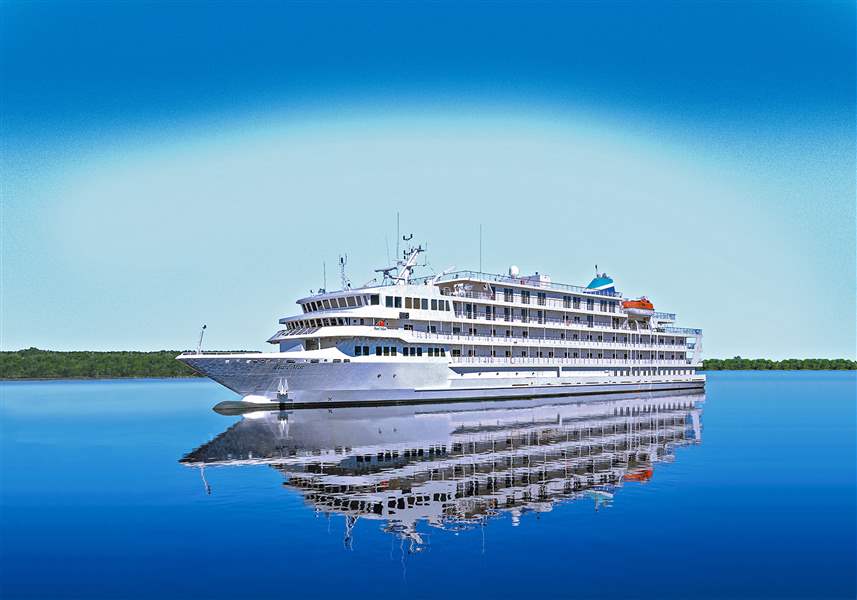
A sketch shows the Pearl Mist, a new ship that will be used for a trio of Great Lake cruises in 2014. Pearl Seas Cruises also plans to cruise between the St. Lawrence River and the Canadian Maritimes.
PEARL SEAS CRUISES

A sketch shows the Pearl Mist, a new ship that will be used for a trio of Great Lake cruises in 2014. Pearl Seas Cruises also plans to cruise between the St. Lawrence River and the Canadian Maritimes.
Next summer, the on-again, off-again Great Lakes cruise industry hopes to begin the renaissance it has envisioned for decades.
But, for now, Toledo has done virtually nothing to be part of it.
Little, if any, of the Toledo-Lucas County Port Authority’s $283,000 marketing budget is dedicated to courting Great Lakes cruise ships.
The port authority has rejected invitations to rejoin the Great Lakes Cruising Coalition, a Kingston, Ont.-based group that markets member communities for a mere $3,700 to $7,000 in annual fees.
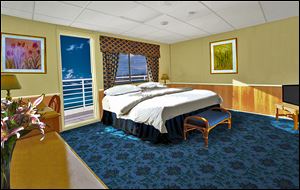
The Pearl Mist has been limited to 100 oversized staterooms, all with private balconies.
Paul Toth, the port board’s president, said he didn’t believe it was getting enough out of its membership. He said the port authority dropped out of the coalition shortly before the Wall Street crisis of 2008, when it faced a tighter budget.
Stephen Burnett, the coalition’s executive director, said he has heard the mind-set is starting to change in Toledo.
But he said the coalition hit a brick wall after being told the city’s emphasis was on cargo shipments — instead of cruise lines.
“We tried a couple of times and decided not to make a nuisance of ourselves,” Mr. Burnett said. “It was the port authority.”
Mr. Burnett said he now sees a bright future for the Great Lakes cruise industry because as many as five cruise lines are expected to offer new trips in 2014, the most in several years. All are to be smaller vessels, holding 100 to 400 people, with the Great Lakes seeing a net increase of 6,000 passengers.
Pearl Seas
Much of the buzz begins with a new company called Pearl Seas Cruises, of Guilford, Conn.
Pearl Seas is an affiliate of American Cruise Lines, a small-ship cruise line established in 1991 that has offered cruises throughout New England, the South, Chesapeake Bay, Alaska, and the Pacific Northwest.
Pearl Seas Cruises has announced on its Web site, www.pearlseascruises.com, that it is taking orders for a trio of Great Lakes cruises, as well as one that will go between the St. Lawrence River and the Canadian Maritimes. Fares range from $5,000 to $9,000 for itineraries of 10 to 14 days, with 9 to 12 ports of call.
The excursions will be aboard a luxury liner, the newly built Pearl Mist cruise ship. The Web site said the ship has been limited to 100 oversized staterooms, all with private balconies.
The Web site states the Pearl Mist, made of six decks and 335 feet long, is small enough for those aboard to cruise into “scenic areas inaccessible to larger ships and make new friends with 200 like-minded passengers as we dock in the heart of small, welcoming coastal towns.”
The ship, in the final phases of construction at Cheasapeake Shipbuilding in Salisbury, Md., has 108 staterooms and a capacity of 210 passengers. All of its staterooms have private balconies. Its staterooms range in size from 302 to 580 square feet, according to the Web site.
None of the stops is planned in Toledo or any other Lake Erie ports, including Cleveland.
Britt Rabinovici, Pearl Seas spokesman, said the company will not disclose its selection criteria.
But she didn’t rule out a stop in Toledo sometime in the future.
“I know our schedules and ports are a work in progress,” she said.
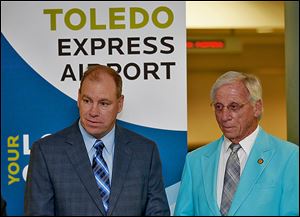
The Toledo-Lucas County Port Authority, led by Paul Toth, left, has rejected invitations to rejoin the Great Lakes Cruising Coalition. Board member Jerry Chabler, right, thinks his agency needs to promote Toledo as a nautical city.
Chris Whyman, visitors services manager for Kingston — Canada’s oldest city and that nation’s first capital — said the coalition helped woo Pearl Seas by playing up the town’s quaint, historic charm and festive atmosphere. The city hosted five cruise line operators on a tour about three years ago, he said.
“They generally coordinate marketing for all of the cruises,” said David Cree, Windsor port authority president and chief executive officer.
Focus on cargo
Joe Cappel, Toledo-Lucas County Port Authority director of cargo development, said the agency’s focus has been almost exclusively on cargo shipments in recent years because the cruise industry has never regained the foothold it once had in the Great Lakes region.
“With our limited resources at the port, we try to focus on things that have the most bang for the buck, which means cargo. But, no, we haven’t been aggressive in marketing Toledo to the cruise-ship industry,” Mr. Cappel said.
Thomas Winston, port authority vice president of administration and chief financial officer, said $102,000 of the agency’s $283,000 advertising, promotions, and marketing budget is dedicated to Toledo Express Airport. The airport is struggling to maintain passenger service.
Some $75,000 more is budgeted for general marketing and communications projects, while $69,000 and $37,000 are dedicated to development and seaport activities, respectively.
“There’s no line item in our budget for marketing Great Lakes cruises,” Mr. Cappel said.
A spot to dock
Toledo’s best spot for docking cruise ships is likely along the Maumee River, next to the future National Museum of the Great Lakes in East Toledo.
The building was initially built by the port authority as a passenger-vessel terminal.
The museum, being developed by the Great Lakes Historical Society, is to open next spring. It will replace the group’s museum in Vermilion, Ohio.
The 300-foot-long dock is used by ferry charters operated by Jet Express, which require less clearance than cruise ships.
The Pearl Mist needs at least 12 feet of water, Ms. Rabinovici said.
Some sediment would likely have to be dredged between the navigational channel and the dock. The amount and cost for doing that is unknown, Mr. Cappel said.
He said the port authority would likely contribute money toward dredging, but said the dock owner is ultimately responsible for any such project.
Chris Gillcrist, the historical society’s executive director, agreed some dredging is likely, But he said he believes costs would be minimal because water between the navigational channel and dock was about 16 feet deep a year ago. The depth changes because of how the river current redeposits silt.
The 300-foot dock could conceivably accommodate the 335-foot cruise ship, provided a little overhang is acceptable, he said.
“It would probably be a tight fit. But, yeah, I think there’s a possibility she could get into that dock,” Mr. Gillcrist said.
Mr. Gillcrist said the market for Great Lakes cruising has been anything but stable since the 1960s.
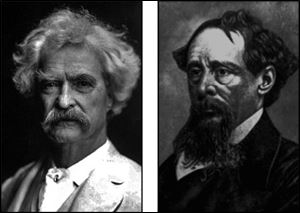
Mark Twain, left, and Charles Dickens were among the most famous passengers of Great Lakes cruise ships in the 1800s.
Steamship era
During an 80-year span, lake-based transportation evolved into something more than that as Americans became more affluent, giving them more leisure time and the ability to take vacations, he said.
Passenger steamships with elegant mahogany and marble staircases became more common. Cruises were offered to cities such as Buffalo to Cleveland to Detroit and back. Niagara Falls became a popular destination for honeymoon cruises, Mr. Gillcrist said.
Many of the ships had libraries and entertainers, such as jazz musicians. He said it’s hard to say when cruising became more about the experience than transportation. But as ships offered souvenir playing cards, collector spoons, tumblers, glasses, key chains, and other trinkets, the industry evolved into more than a simple ferry service.
Charles Dickens and Mark Twain were among the most famous passengers of Great Lakes cruise ships in the 1800s. An April 24, 1842, diary entry from Mr. Dickens talks about a “grand tour” of North America via Lake Erie steamship cruises that had “very few passengers aboard and had bountiful and handsome accommodation,” according to the Great Lakes Cruising Coalition.
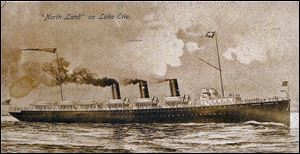
Mark Twain traveled on the North Land while touring America from Cleveland to Mackinac Island and Duluth. The Northern Steamship Co.'s motto was: "In all the world no trip like this."
‘A niche market’
Today, the region is caught in a chicken-and-egg paradox: It’s hard to persuade cruise companies to come to the Great Lakes when many past operators have left, claiming the market isn’t strong enough. But without long-term commitments, it’s hard to court them too.
“It’s very much a niche market,” Mr. Gillcrist said. “If we knew it was going to be a 10-year investment, it might be worth more of your energy to go after them.”
Some historians believe the domestic market for Great Lakes cruises waned as the national Interstate Highway System started in the 1950s under President Dwight D. Eisenhower and air travel grew in popularity starting in the 1960s.
But a spate of fires in the 1940s and 1950s didn’t help.
Although the boat hulls were made of steel, many of the vessels had a lot of wood in their structures, Mr. Gillcrist said.
“To retrofit all of these old boats with new bodies didn’t make [economic] sense,” he said.
Port authority member Jerry Chabler said his agency needs to rethink its position on cruising and promote Toledo as a nautical city.
“No doubt about it. We have an exciting skyline, especially from the river,” Mr. Chabler said.
He said he’s been a board member 14 years and never knew about the Great Lakes Cruising Coalition. Knowledge of the membership never reached the board.
Recent visits
The last cruise ships to visit Toledo called during the late 1990s. The 100-passenger M.V. Nantucket Clipper used Toledo as a starting or ending point for Great Lakes cruises from 1996 through 1998, and the 400-passenger C. Columbus took on a shipload of German tourists for a voyage to Quebec City in 1997.
But the C. Columbus took a 45-minute delay at one of Toledo’s railroad bridges, and so the origin of a similar cruise the following year was moved to Detroit. The Nantucket Clipper’s revised itineraries in 1999 came no closer than Windsor, Ont.
Mr. Cappel agreed that getting the cruise ship industry back into Toledo could be a “catalyst” for other economic development along the Maumee River shoreline, such as the Marina District.
“We want action down there. With the museum there, there’s a reason for people to come,” he said.
Cities benefit more when they can rebrand themselves on Facebook, Twitter, and other social media sites, Mr. Gillcrist said.
“When you can have photos of a cruise ship in your downtown, it shows people the river isn’t dead,” he said.
Mayor Mike Bell’s administration sees the possibility of Great Lakes cruise ships in Toledo as a way to better market the city as a nautical destination, something that could broaden the city’s appeal via Facebook and other social media, said Jen Sorgenfrei, Mr. Bell’s spokesman.
She called it “tourist street-cred.”
“If you’re getting people to stop here and take pictures, that’s word-of-mouth advertising you can’t get with any magazine ad. It has a certain legitimacy,” Ms. Sorgenfrei said.
Richard Nachazel, president of Destination Toledo Inc., the city’s convention and visitors bureau, said he “would certainly participate with other people to learn more about it.”
“I’m guessing everyone would be on board,” he said.
Contact Tom Henry at: thenry@theblade.com or 419-724-6079.